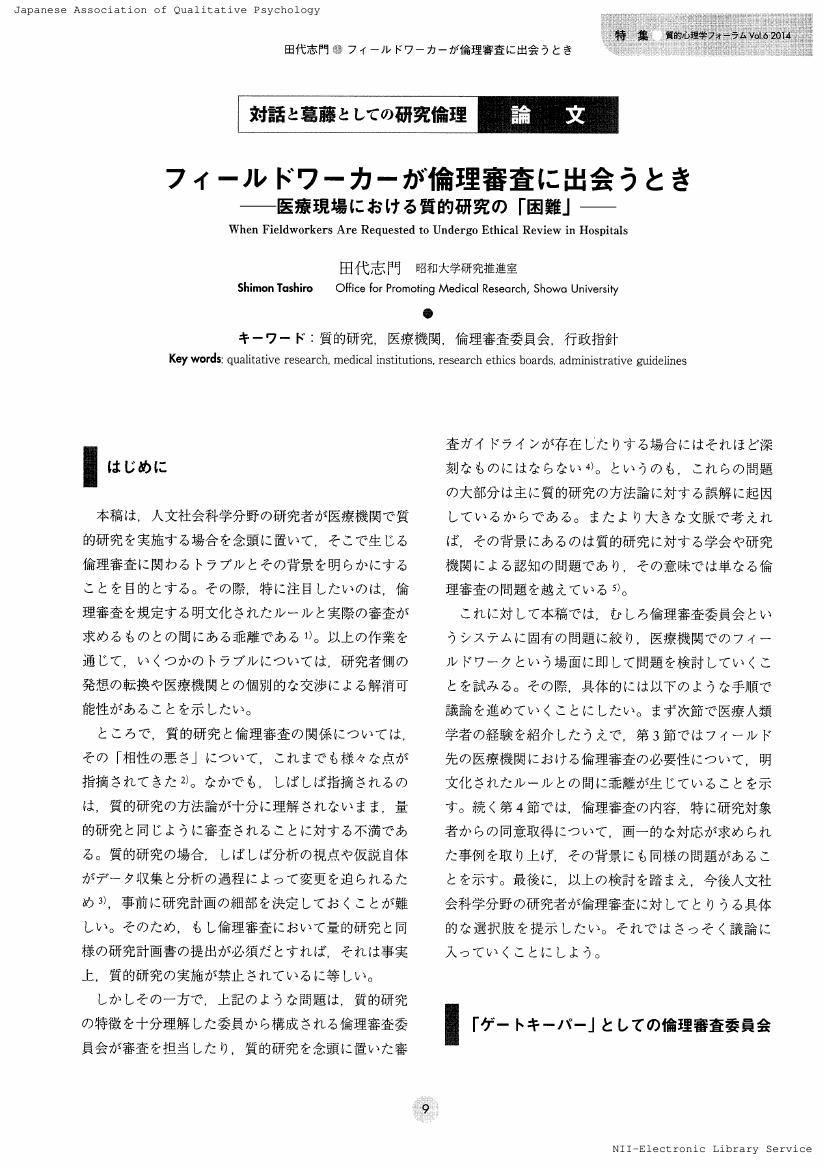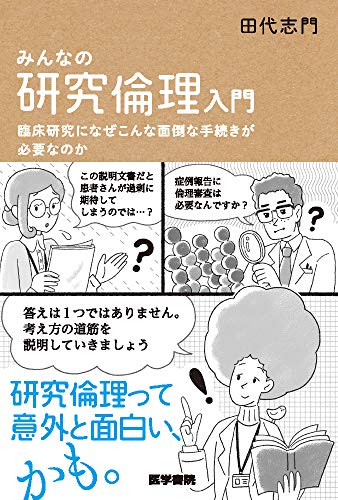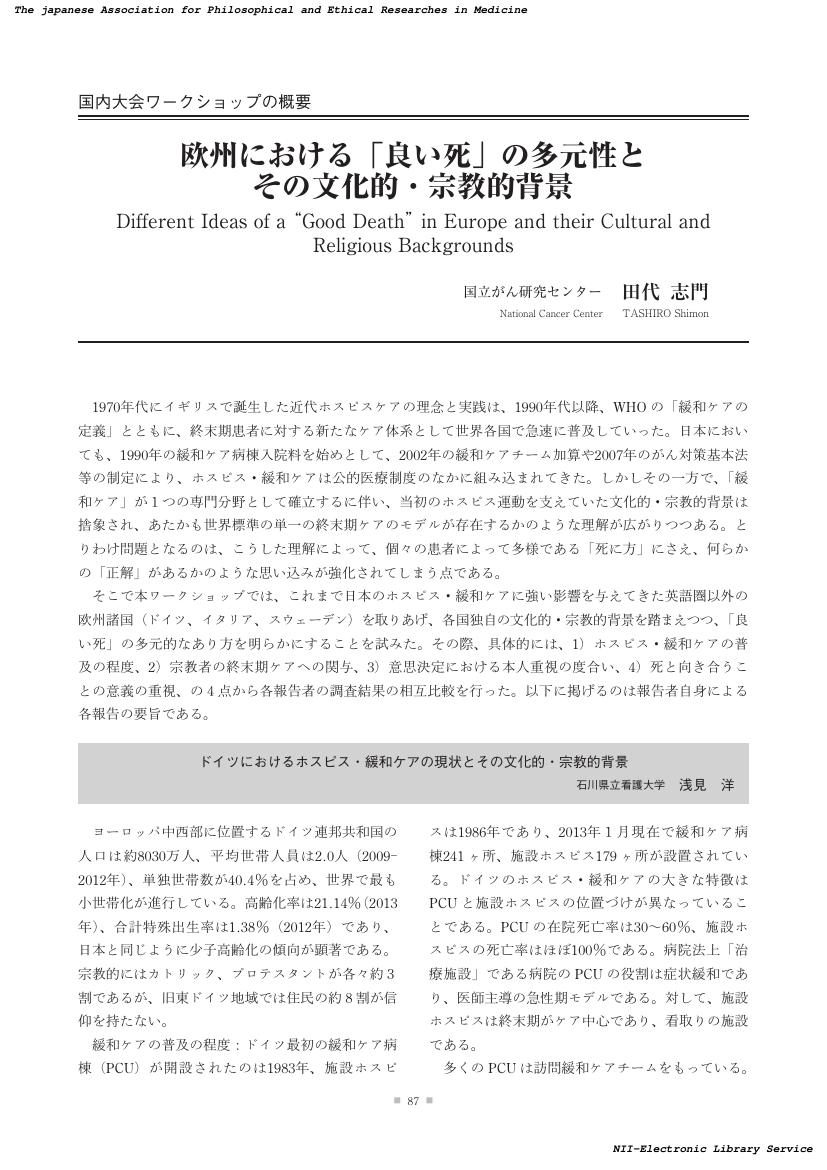29 0 0 0 OA 現代の看取りにおける<お迎え>体験の語り : 在宅ホスピス遺族アンケートから
- 著者
- 諸岡 了介 相澤 出 田代 志門 岡部 健
- 出版者
- 東京大学グローバルCOEプログラム「死生学の展開と組織化」
- 雑誌
- 死生学研究 (ISSN:18826024)
- 巻号頁・発行日
- vol.9, pp.205-223, 2008-03-15
3 0 0 0 OA 特集論文 フィールドワーカーが倫理審査に出会うとき 医療現場における質的研究の「困難」
- 著者
- 田代 志門
- 出版者
- 日本質的心理学会
- 雑誌
- 質的心理学フォーラム (ISSN:18842348)
- 巻号頁・発行日
- vol.6, pp.9-17, 2014 (Released:2020-03-11)
- 被引用文献数
- 3
3 0 0 0 IR 現代の看取りにおける〈お迎え〉体験の語り--在宅ホスピス遺族アンケートから
- 著者
- 諸岡 了介 相澤 出 田代 志門 岡部 健
- 出版者
- 東京大学グローバルCOEプログラム「死生学の展開と組織化」
- 雑誌
- 死生学研究 (ISSN:18826024)
- 巻号頁・発行日
- no.9, pp.223-205, 2008-03
- 著者
- 田代 志門
- 出版者
- 日本保健医療社会学会
- 雑誌
- 保健医療社会学論集 (ISSN:13430203)
- 巻号頁・発行日
- vol.26, no.2, pp.21-30, 2016-01-31 (Released:2017-08-30)
- 参考文献数
- 23
本稿では、現代的な死にゆく過程の成立をある医師の個人史と重ねて整理し、それが以下の3段階から形成されていることを明らかにした。まず、病院での死が当たり前となり、死にゆく過程が医療の管理下に置かれるようになること。次にその過程で「一分一秒でも長く生かす」ことの正しさが疑われるような局面が表面化すること。最後にこうした難しい局面においては、本人が死の近いことを知ったうえで、主体的に「生き方」を選択するという規範が支持されるようになること。これにより、「自分の死が近いことを認識している人間が残された生をどう生きるべきか思い悩む」という実存的問題が「発見」され、それが医療スタッフの経験する困難にも質的変化をもたらした。以上の変化を受けて、医療社会学には専門家による「生き方の道徳化」を批判的に検討しつつも、現代的な死にゆく人役割の困難さの内実に迫る研究に取り組むことが求められている。
2 0 0 0 OA 現代の看取りにおける<お迎え>体験の語り : 在宅ホスピス遺族アンケートから
- 著者
- 諸岡 了介 相澤 出 田代 志門 岡部 健
- 出版者
- 東京大学グローバルCOEプログラム「死生学の展開と組織化」
- 雑誌
- 死生学研究 (ISSN:18826024)
- 巻号頁・発行日
- vol.9, pp.205-223, 2008-03-15
2 0 0 0 IR 現代の看取りにおける<お迎え>体験の語り : 在宅ホスピス遺族アンケートから
- 著者
- 諸岡 了介 相澤 出 田代 志門 岡部 健
- 出版者
- 東京大学グローバルCOEプログラム「死生学の展開と組織化」
- 雑誌
- 死生学研究 (ISSN:18826024)
- 巻号頁・発行日
- no.9, pp.205-223, 2008-03-15
application/pdf
- 著者
- 田代 志門
- 出版者
- 東北社会学研究会
- 雑誌
- 社会学研究 (ISSN:05597099)
- 巻号頁・発行日
- no.93, pp.5-28, 2014
1 0 0 0 臨床研究の包括的法規制のあり方に関する多分野横断的研究
- 著者
- 米村 滋人 水野 紀子 武藤 香織 磯部 哲 徳永 勝士 田代 志門 奥田 純一郎 中山 茂樹 佐藤 雄一郎 猪瀬 貴道
- 出版者
- 東京大学
- 雑誌
- 基盤研究(A)
- 巻号頁・発行日
- 2018-04-01
2018年度分の研究活動(2018年4月~2020年3月)の実績の概要は以下の通り。当年度は、まず、総合調整班において全体的な研究計画と調査項目・検討課題を決定した。具体的には、先行研究課題である科研費・基盤研究(A)(課題番号24243017)の研究成果として、米村編『生命科学と法の近未来』(信山社、2018)が公表されているため、これを素材に国内外の関連研究者・専門家等からの意見と課題提示を受けた上で、総合調整班において検討を行った。その結果、現在の日本では臨床研究法をめぐる法運用が多大な混乱を惹起しており、医学界からは臨床研究全体が抑制されているとの指摘も見られるため、臨床研究法の法規制のあり方を検討することが適切と考えられ、海外法制度調査もその観点を中心に行う方針とした。以上をもとに、一般的実体要件班・一般的手続要件班において、国内の法学・生命倫理学・医学関係者に臨床研究法の問題点や改善の方向性等につき意見聴取を行うほか、海外の文献調査や国外の機関に対する訪問調査を行う方針とした。国内調査に関しては、各研究分担者の調査内容を研究会の場で共有したほか、永井良三・自治医科大学長や藤井眞一郎・理化学研究所生命医科学研究センターチームリーダーなど医学研究者の意見を直接聴取した。また、ドイツの臨床研究規制については、ヨッヘン・タウピッツ教授を始めマンハイム大学医事法研究所のスタッフに調査を依頼しており、その中間報告を数度にわたり聴取したほか、フランスの臨床研究規制についても文献調査の形で調査を進め、2019年3月に研究分担者・磯部哲と研究協力者・河嶋春菜の助力によりフランス渡航調査を実施した。特殊研究規制検討班においては、研究分担者・徳永勝士を中心に、国内研究機関や海外研究機関・研究者に対するヒアリング調査を行う形でゲノム研究や再生医療研究の規制状況の調査を行った。
1 0 0 0 OA 欧州における「良い死」の多元性とその文化的・宗教的背景(国内大会ワークショップの概要)
- 著者
- 田代 志門
- 出版者
- 日本医学哲学・倫理学会
- 雑誌
- 医学哲学 医学倫理 (ISSN:02896427)
- 巻号頁・発行日
- vol.33, pp.87, 2015-09-30 (Released:2018-02-01)
1 0 0 0 OA 国際共同研究の倫理 研究の「利益」とグローバルな正義
- 著者
- 田代 志門
- 出版者
- 日本医学哲学・倫理学会
- 雑誌
- 医学哲学 医学倫理 (ISSN:02896427)
- 巻号頁・発行日
- vol.32, pp.96-100, 2014 (Released:2018-02-01)
1 0 0 0 OA 研究と診療を区別する二つのモデル : ヘルシンキ宣言からベルモント・レポートへ
- 著者
- 田代 志門
- 出版者
- 日本医学哲学・倫理学会
- 雑誌
- 医学哲学 医学倫理 (ISSN:02896427)
- 巻号頁・発行日
- vol.25, pp.21-29, 2007-10-18 (Released:2018-02-01)
The purpose of this paper is to clarify the logical construction of Robert J. Levine's model for the distinction between research and therapy. Levine's model has been adopted in well-known ethical guidelines such as the Belmont Report (1979) and the CIOMS guidelines (1993). Levine introduced into research ethics two theoretical models, the intent-based model and the approval-based model, for the distinction between research and therapy. He also recommended that physician-investigators deal with "innovative therapy" as research, which should be reviewed by IRBs. Levine criticized two assumptions which were largely shared in the medical community in the 1960's. Some physician-investigators thought that it was impossible to distinguish research from therapy because all medical practice was in a sense experimental. Others thought we should distinguish therapeutic research from non-therapeutic research and that the former can be conducted according to relatively relaxed standards. This was also the standpoint of the Declaration of Helsinki in 1964. These assumptions interfered with effective regulation of clinical research. Levine's model introduced a new perspective into research ethics and became a foundation of the contemporary regulation of clinical research. The purpose of this paper is not only to reconstruct past discussion and share its heritage but also to obtain suggestions for the regulation of clinical research in Japan.
- 著者
- 田代 志門
- 出版者
- 社会調査協会 ; 2008-
- 雑誌
- 社会と調査
- 巻号頁・発行日
- no.12, pp.5-12, 2014-03
1 0 0 0 OA ケア実践に関わる死生観の地域的・文化的多様性に関する複合的研究
本研究プロジェクトでは、ケア実践との関連において現代日本における死生観の実態を明らかにすべく、各種の質的調査や、思想史的・宗教史的考察、海外事情の研究といった分担研究を集約しながら、在宅ホスピスを利用した患者遺族を対象とした大規模な調査票調査を実施した。調査票調査では、宮城県・福島県における在宅ホスピス診療所6カ所の利用者2223名に依頼状を送付して、663通の回答が得られた。その分析から、在宅療養時の患者や家族の不安感やニーズの詳細とともに、宗教的関心に経済的・社会的関心が絡み合った死生観の具体相が明らかにされた。
- 著者
- 田代 志門
- 出版者
- 日本保健医療社会学会
- 雑誌
- 保健医療社会学論集 (ISSN:13430203)
- 巻号頁・発行日
- vol.26, no.2, pp.21-30, 2016
本稿では、現代的な死にゆく過程の成立をある医師の個人史と重ねて整理し、それが以下の3段階から形成されていることを明らかにした。まず、病院での死が当たり前となり、死にゆく過程が医療の管理下に置かれるようになること。次にその過程で「一分一秒でも長く生かす」ことの正しさが疑われるような局面が表面化すること。最後にこうした難しい局面においては、本人が死の近いことを知ったうえで、主体的に「生き方」を選択するという規範が支持されるようになること。これにより、「自分の死が近いことを認識している人間が残された生をどう生きるべきか思い悩む」という実存的問題が「発見」され、それが医療スタッフの経験する困難にも質的変化をもたらした。以上の変化を受けて、医療社会学には専門家による「生き方の道徳化」を批判的に検討しつつも、現代的な死にゆく人役割の困難さの内実に迫る研究に取り組むことが求められている。
- 著者
- 田代 志門
- 出版者
- 日本精神保健看護学会
- 雑誌
- 日本精神保健看護学会誌 (ISSN:09180621)
- 巻号頁・発行日
- vol.25, no.2, pp.70-77, 2016
- 著者
- 田代 志門
- 出版者
- 日本医学哲学・倫理学会
- 雑誌
- 医学哲学医学倫理 (ISSN:02896427)
- 巻号頁・発行日
- no.25, pp.21-29, 2007-10-18
The purpose of this paper is to clarify the logical construction of Robert J. Levine's model for the distinction between research and therapy. Levine's model has been adopted in well-known ethical guidelines such as the Belmont Report (1979) and the CIOMS guidelines (1993). Levine introduced into research ethics two theoretical models, the intent-based model and the approval-based model, for the distinction between research and therapy. He also recommended that physician-investigators deal with "innovative therapy" as research, which should be reviewed by IRBs. Levine criticized two assumptions which were largely shared in the medical community in the 1960's. Some physician-investigators thought that it was impossible to distinguish research from therapy because all medical practice was in a sense experimental. Others thought we should distinguish therapeutic research from non-therapeutic research and that the former can be conducted according to relatively relaxed standards. This was also the standpoint of the Declaration of Helsinki in 1964. These assumptions interfered with effective regulation of clinical research. Levine's model introduced a new perspective into research ethics and became a foundation of the contemporary regulation of clinical research. The purpose of this paper is not only to reconstruct past discussion and share its heritage but also to obtain suggestions for the regulation of clinical research in Japan.
1 0 0 0 OA 現代の看取りにおける<お迎え>体験の語り : 在宅ホスピス遺族アンケートから
- 著者
- 諸岡 了介 相澤 出 田代 志門 岡部 健
- 出版者
- 東京大学グローバルCOEプログラム「死生学の展開と組織化」
- 雑誌
- 死生学研究 (ISSN:18826024)
- 巻号頁・発行日
- vol.9, pp.205-223, 2008-03-15 (Released:2009-03-09)



